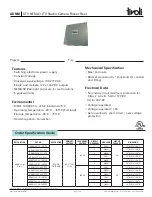
20
TK-890/
(
B
)
/H
(
B
)
6-3. Modification to increase the audio output of
the control head
The speaker output can be increased to 13W by moving
jumper resistor (0 ohm) R628 on the control unit (X57-562
B/3) to R627. In this case, the KCH-10 internal speaker can-
not be used because the maximum input (3W) of the inter-
nal speaker is exceeded. Therefore, use the KES-4.
Note :
Even if the KRK-6DH is modified in this way, the au-
dio output of head 2 cannot be increased.
To increase the audio output of head 2 of the KRK-8DBH,
modify radio 2 in the same manner.
6-4. Use as public address speaker
1. Remove the short plug from the 9-pin accessory connec-
tor on the rear of the radio. (Remove the jumpers as de-
scribed in Section 5-1.)
2. Insert the KES-4 speaker leads into pins 7 and 8.
3. If you remove jumper shorting pins 3 and 6, the 20W PA
(public address) voice signal is output from pins 7 and 8.
(Only when the PA or SP switch is on.)
4. If you use the radio with pins 3 and 6 shorted, the internal
speaker is available (when the KCH-10 is used). The KCH-
11 does not contain a speaker.
Note :
Relation ship between accessory connector (9-pins)
connection and speaker output.
When pins 3 and 6 are shorted ; The 3W internal speaker is
used (KCH-10 only).
When pins 3 and 6 are open and output is from pins 7 and 8
; The 20W external speaker is used.
Default
Modification 1
Modification 2
R690
Present
Present
Absent
R691
Present
Absent
Absent
R692
Absent
Present
Present
State
Table 2 (Refer to page 21)
8. Accessory Terminal Function
8-1. 25-pin accessory terminal
• Pin 13
MI/DI (MIC Signal Input/Output or Data Audio Input)
This pin has one of the two functions listed in Table 3 by
setting jumper resistors (0 ohm) R640 and R641 on the
control unit (X57-562 B/3) (Refer to page 21).
1) MIC signal input/output
This pin is directly connected to the MIC input pin of the
transceiver, so it has the same function as the MIC input
pin. When the input is 5mV/3 kHz, DEV (600 ohms)
modulation is obtained. The MIC input is output from the
transceiver panel as it is.
2) Data audio input
The signal from this pin passes through the LPF (fc: about
10kHz), is summed with the MIC AMP output, and goes
to the modulator. Therefore, it is not preemphasized.
• Pin 14
SB (DC Power Output After Power Switch)
The maximum output (13.6V : TK-890/(B), 13.4V : TK-
890H(B) / 0.5A) can be obtained by modifying the control
unit as follows:
Short the land of the print pattern near CN505 of the con-
trol unit (X57-562 B/3).
R640
R641
Function
Present
Absent
MIC signal input/output
Absent
Present
DATA audio input : Default
Table3 (Refer to page 21)
9. Connection with the Remote Kit
When the KRK-5, KRK-6DH, KRK-7DB or KRK-8DBH is
used, set chip resistors and transistors as shown in the table
below.
KRK-5
KRK-6DH
KRK-7DB
KRK-8DBH
Radio 1
Unnecessary
Radio 2
–
Remove R546 and R661
Move R602 to R705.
Table 4 (Refer to page 21)
INSTALLATION
7
8
Plug (9P)
Crimp terminal
(E23-0613-05)
To KES-4
Black lead
Black/White lead
Fig. 11
7. Horn Alert Function
The HR1 pin of the accessory connector (9-pin) on the
rear of the transceiver is an open collector and the maxi-
mum current is 100mA. The maximum available current can
be increased to 1A by installing a relay.
1. Remove the upper half of the case of the TK-890.
2. Move jumper resistor (0 ohm) R691 on the control unit
(X57-562 B/3) to R692. To make the HR2 pin, remove
R692 (Refer to page 21).
3. Remove screws and erect the PC board. Install and sol-
der relay K501 (Part No. : S76-0407-05).
4. Reinstall the PC board and the upper half of the case.
HR1
HR2
HR1
HR2
HR1
HR2














































